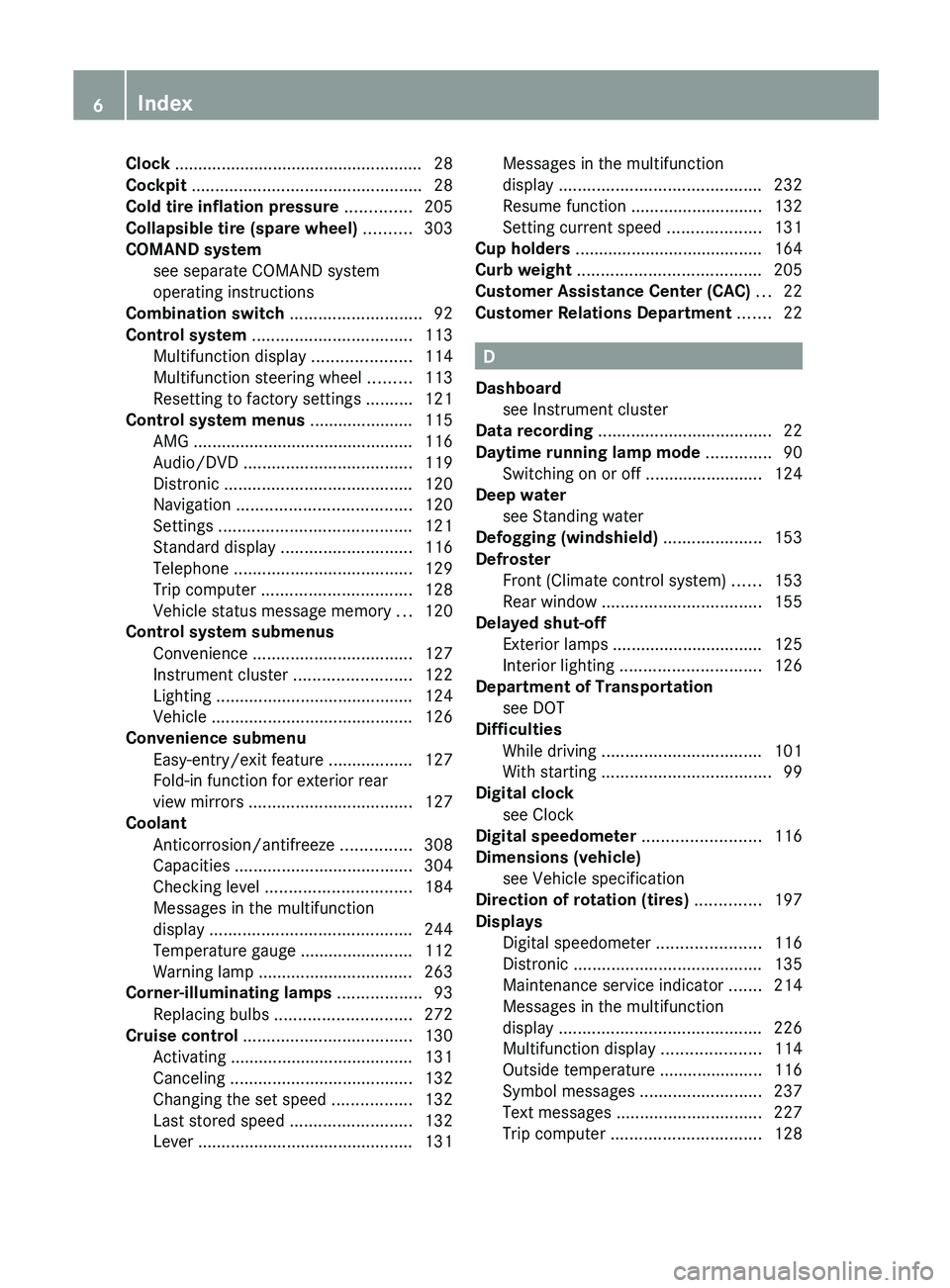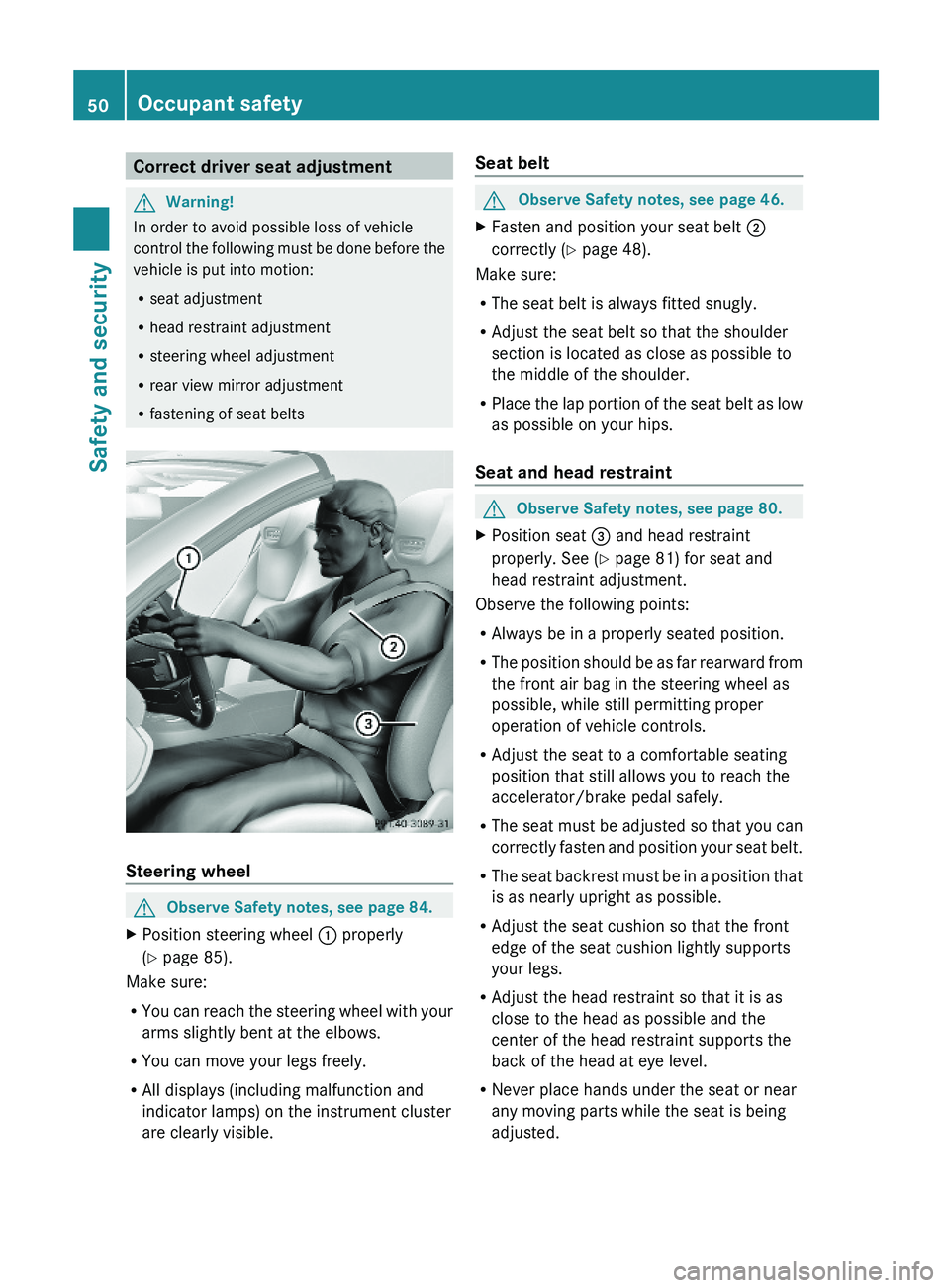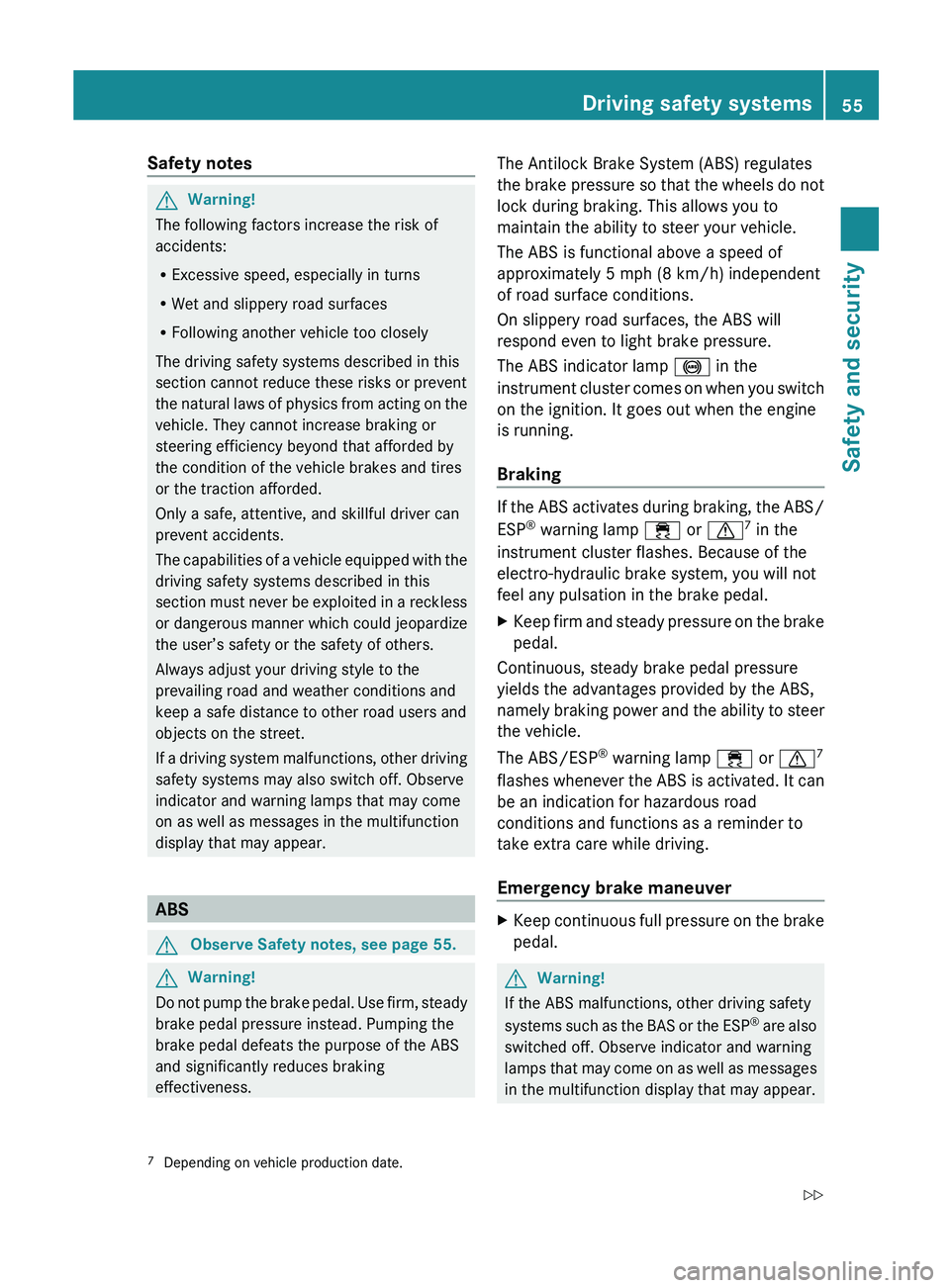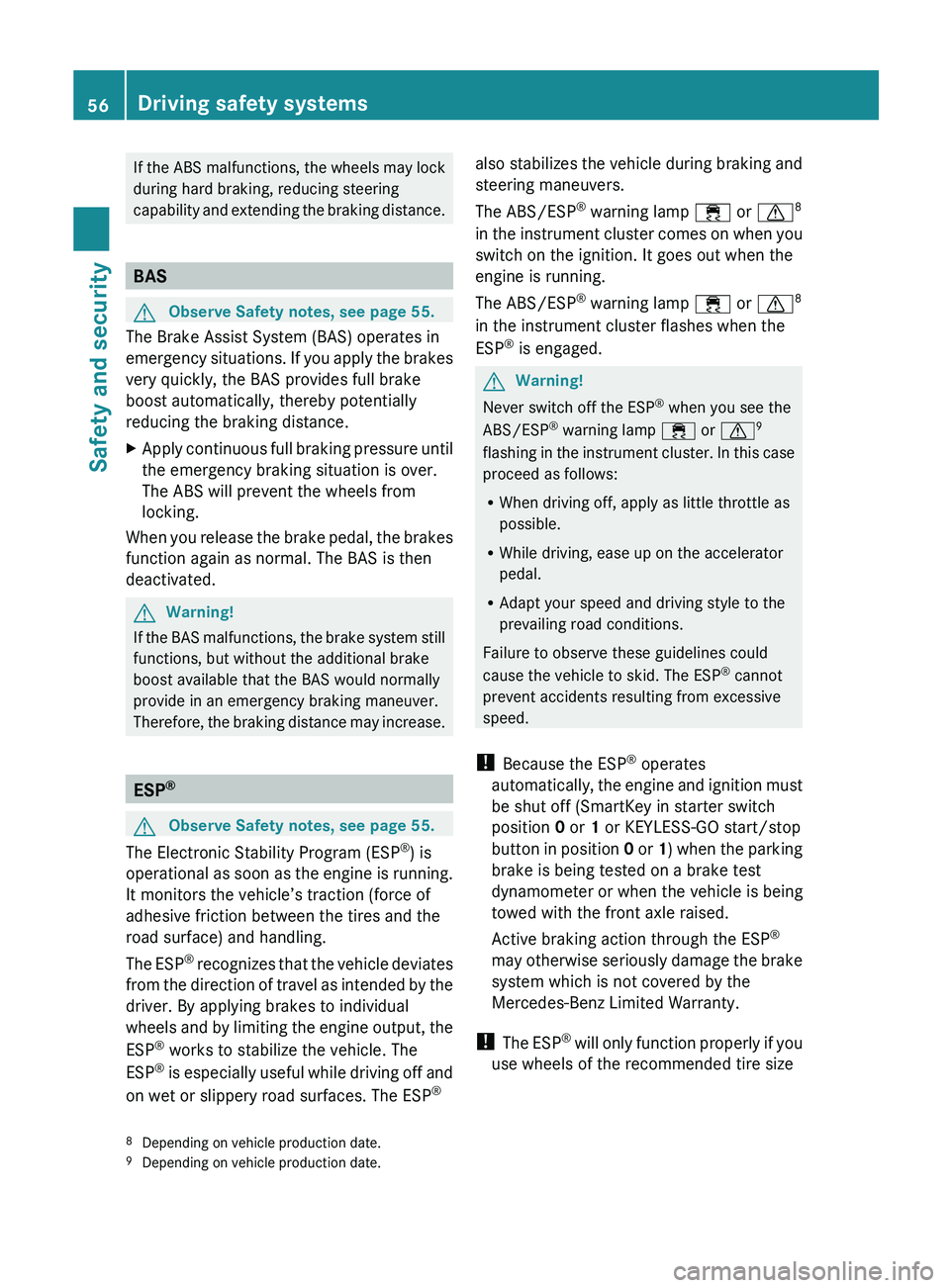instrument cluster MERCEDES-BENZ SL CLASS 2011 Owners Manual
[x] Cancel search | Manufacturer: MERCEDES-BENZ, Model Year: 2011, Model line: SL CLASS, Model: MERCEDES-BENZ SL CLASS 2011Pages: 316, PDF Size: 6.55 MB
Page 8 of 316

Clock ..................................................... 28
Cockpit ................................................. 28
Cold tire inflation pressure .............. 205
Collapsible tire (spare wheel) .......... 303
COMAND system see separate COMAND system
operating instructions
Combination switch ............................ 92
Control system .................................. 113
Multifunction display .....................114
Multifunction steering wheel .........113
Resetting to factory settings ..........121
Control system menus ...................... 115
AMG ............................................... 116
Audio/DVD .................................... 119
Distronic ........................................ 120
Navigation ..................................... 120
Settings ......................................... 121
Standard display ............................ 116
Telephone ...................................... 129
Trip computer ................................ 128
Vehicle status message memory ...120
Control system submenus
Convenience .................................. 127
Instrument cluster .........................122
Lighting .......................................... 124
Vehicle ........................................... 126
Convenience submenu
Easy-entry/exit feature .................. 127
Fold-in function for exterior rear
view mirrors ................................... 127
Coolant
Anticorrosion/antifreeze ...............308
Capacities ...................................... 304
Checking level ............................... 184
Messages in the multifunction
display ........................................... 244
Temperature gauge ........................ 112
Warning lamp ................................. 263
Corner-illuminating lamps .................. 93
Replacing bulbs ............................. 272
Cruise control .................................... 130
Activating ....................................... 131
Canceling ....................................... 132
Changing the set speed .................132
Last stored speed ..........................132
Lever .............................................. 131Messages in the multifunction
display ........................................... 232
Resume function ............................ 132
Setting current speed ....................131
Cup holders ........................................ 164
Curb weight ....................................... 205
Customer Assistance Center (CAC) ... 22
Customer Relations Department ....... 22
D
Dashboard see Instrument cluster
Data recording ..................................... 22
Daytime running lamp mode .............. 90
Switching on or off ......................... 124
Deep water
see Standing water
Defogging (windshield) ..................... 153
Defroster
Front (Climate control system) ......153
Rear window .................................. 155
Delayed shut-off
Exterior lamps ................................ 125
Interior lighting .............................. 126
Department of Transportation
see DOT
Difficulties
While driving .................................. 101
With starting .................................... 99
Digital clock
see Clock
Digital speedometer ......................... 116
Dimensions (vehicle) see Vehicle specification
Direction of rotation (tires) .............. 197
Displays
Digital speedometer ......................116
Distronic ........................................ 135
Maintenance service indicator .......214
Messages in the multifunction
display ........................................... 226
Multifunction display .....................114
Outside temperature ...................... 116
Symbol messages ..........................237
Text messages ............................... 227
Trip computer ................................ 128
6Index230_AKB; 6; 22, en-USd2ureepe,Version: 2.11.8.12009-07-28T18:49:58+02:00 - Seite 6
Page 11 of 316

Limiting .......................................... 108
Shifting into optimal ......................109
Gear selector lever ............................ 103
Cleaning ......................................... 220
Gearshift pattern ........................... 103
Lock ......................................... 99, 103
Messages in the multifunction
display ........................................... 234
Shifting procedure .........................104
Transmission position indicator .....104
Transmission positions ..................104
Generator
see Alternator
Global locking/unlocking
see Key, SmartKey
Glove box ........................................... 161
Gross Axle Weight Rating see GAWR
Gross Vehicle Weight
see GVW
Gross Vehicle Weight Rating
see GVWR
GVW (Gross Vehicle Weight) ............ 206
GVWR (Gross Vehicle Weight
Rating) ................................................ 206
H
Hard plastic trim items, cleaning .... 220
Hazard warning flasher ....................... 92
Headlamp cleaning system ................ 93
Headlamps
Active Bi-Xenon headlamps .............89
Automatic headlamp mode ..............90
Bi-Xenon .................................. 89, 272
Cleaning lenses ............................. 218
Cleaning system .............................. 93
Daytime running lamp mode ............90
Delayed shut-off ............................ 125
High-beam flasher ............................ 92
High-beam headlamps .....................92
Low-beam headlamps ......................90
Messages in the multifunction
display ........................................... 249
Replacing bulbs ............................. 271
Switch .............................................. 89
Headliner, cleaning and care of ....... 220
Head restraints .................................... 80
Adjustment ...................................... 80
Head-thorax air bags ........................... 42
Height adjustment
Seats ............................................... 80
High-beam flasher ............................... 92
High-beam headlamps ................ 92, 272
Indicator lamp ............................ 31, 32
Replacing bulbs ............................. 272
High-performance brake system ..... 211
Hill-start assist system ..................... 142
Hood ................................................... 180
Messages in the multifunction
display ........................................... 241
Horn ...................................................... 28
Hydroplaning ..................................... 212
I
Identification labels .......................... 294
Identification number, vehicle
(VIN) ................................................... 295
Ignition ..................................... 78, 79, 99
Immobilizer .......................................... 63
Indicator lamps see Lamps, indicator and warning
Infant and child restraint systems
see Children in the vehicle
Inflation pressure
see Tires, Inflation pressure
Inside door handle ........................ 35, 72
Instrument cluster ...................... 30, 111
Illumination .................................... 112
Lamps ............................................ 254
Multifunction display .....................114
Instrument lighting
see Instrument cluster, Illumination
Instrument panel
see Instrument cluster
Instruments and controls
see Cockpit
Interior lighting ................................... 94
Delayed shut-off ............................ 126
Reading lamps ................................. 94
Interior rear view mirror ..................... 86
Auto-dimming rear view mirrors ....... 86
Interior storage spaces
see Storage compartments
Index9230_AKB; 6; 22, en-USd2ureepe,Version: 2.11.8.12009-07-28T18:49:58+02:00 - Seite 9
Page 12 of 316

Intermittent wiping ............................. 95
Rain sensor ...................................... 95
J
Jack ..................................................... 225
Jump starting ..................................... 285
K
Key, Mechanical
Loss of ............................................. 72
Replacing ......................................... 72
Unlocking/locking manually ..........267
Valet locking .................................... 77
Key, SmartKey
Battery check lamp ..........................71
Checking batteries ...........................71
Factory setting ........................... 69, 71
Global locking (KEYLESS-
GO) .................................................. 71
Global locking (SmartKey) ................ 69
Global unlocking (KEYLESS-
GO) .................................................. 71
Global unlocking
(SmartKey) ....................................... 69
Important notes on KEYLESS-GO .....70
Locking/unlocking ........................... 68
Loss of ............................................. 72
Messages in the multifunction
display ........................................... 242
Opening, trunk ................................. 73
Remote control ................................ 68
Replacing ......................................... 72
Replacing batteries ........................269
Restoring to factory setting .......69, 71
Selective setting ........................69, 71
Starter switch positions ...................78
KEYLESS-GO
Starter switch positions ...................79
Kickdown ........................................... 105
Kickdown (manual shift program) ... 111
Kilopascal (air pressure unit) ........... 206
Knee bag .............................................. 42
L
Labels
Certification ................................... 294
Emission control information .........295
Tire and Loading Information
placard ........................................... 193
Tire inflation pressure ....................188
Lamps, exterior
Exterior lamp switch ........................89
Front .............................................. 272
Messages in the multifunction
display ........................................... 249
Rear ............................................... 272
Switching on/off .............................. 89
Lamps, indicator and warning
ABS ................................... 31, 32, 255
Brakes ..................................... 30, 255
Coolant .......................................... 263
Distance warning
lamp .............................. 135, 140, 262
Engine
malfunction
.......................................... 31, 32, 263
ESP ®
................................ 30, 259, 260
ESP ®
OFF ........................... 31, 32, 259, 261
Fog lamps ........................................ 91
Fuel tank
reserve .............................. 31, 32, 262
High-beam
headlamps
............................................ 31, 32, 92
Instrument cluster ...................30, 254
Low tire pressure/TPMS
malfunction telltale ........................265
Passenger front air bag
off ...................................... 33, 43, 266
Roll bar .......................................... 258
Seat belt
telltale
.................................... 31, 32, 48, 256
SPORT handling mode .....................31
SRS ............................. 31, 32, 38, 257
Turn signals ..................................... 30
Language, selecting .......................... 12310Index230_AKB; 6; 22, en-USd2ureepe,Version: 2.11.8.12009-07-28T18:49:58+02:00 - Seite 10
Page 27 of 316

Exterior view .......................................26
Multifunction steering wheel .............27
Cockpit .................................................28
Instrument cluster ..............................30
Center console ....................................33
Overhead control panel ......................35
Door control panel ..............................35
25At a glance230_AKB; 6; 22, en-USd2ureepe,Version: 2.11.8.12009-07-28T18:49:58+02:00 - Seite 25
Page 32 of 316

Instrument clusterFunctionPage\000FCoolant temperature gauge112\000
Page 40 of 316

Vehicle equipment
i This Operator’s Manual describes all
features, standard or optional, potentially
available for your vehicle at the time of
purchase. Please be aware that your
vehicle might not be equipped with all
features described in this manual.
Occupant safety
Introduction
In this section you will learn the most
important facts about the restraint system
components of the vehicle.
The restraint systems are:
R Seat belts
R Child restraints
Additional protection potential is provided by:
R
Supplemental Restraint System (SRS) with
- Air bags
- Air bag control unit (with crash sensors)
-
Emergency Tensioning Device (ETD) for
seat belts
- Seat belt force limiter
R Roll bar
R Air bag system components with
- Passenger front air bag off indicator lamp
- Passenger seat with
Occupant
Classification System (OCS)
Although the systems are independent, their
protective functions work in conjunction with
each other.
GWarning!
Modifications to or work improperly
conducted on restraint system components
or their wiring, as well as tampering with
interconnected electronic systems, can lead
to the restraint systems no longer functioning
as intended.
Air bags or Emergency Tensioning Devices
(ETDs), for example, could deploy
inadvertently or fail to deploy in accidents
although the deceleration threshold for air
bag deployment is exceeded. Therefore,
never modify the restraint systems. Do not
tamper with electronic components or their
software.
i See “Children in the vehicle”
( Y page 51) for information on
R infants and children traveling with you in
the vehicle
R restraint systems for infants and children
SRS indicator lamp
The SRS system conducts a self-test when
the ignition is switched on and in regular
intervals while the engine is running. This
facilitates detection of system malfunctions.
The SRS indicator lamp 008A in the
instrument cluster comes on when the
ignition is switched on. It goes out no later
than a few seconds after the engine has been
started.
The SRS components are in operational
readiness when the SRS indicator lamp
008A is not lit while the engine is running.
GWarning!
The SRS self-check has detected a
malfunction when the SRS indicator lamp
008A
R does not come on at all
R fails to go out after approximately
4 seconds after the engine was started
R comes on after the engine was started or
while driving
For your safety, we strongly recommend that
you contact an authorized Mercedes-Benz
Center immediately to have the system
checked. Otherwise the SRS may not be
activated when needed in an accident, which
38Occupant safetySafety and security
230_AKB; 6; 22, en-USd2ureepe,Version: 2.11.8.12009-07-28T18:49:58+02:00 - Seite 38
Page 52 of 316

Correct driver seat adjustmentGWarning!
In order to avoid possible loss of vehicle
control the following must be done before the
vehicle is put into motion:
Rseat adjustment
Rhead restraint adjustment
Rsteering wheel adjustment
Rrear view mirror adjustment
Rfastening of seat belts
Steering wheel
GObserve Safety notes, see page 84.XPosition steering wheel \000F properly
(Y page 85).
Make sure:
RYou can reach the steering wheel with your
arms slightly bent at the elbows.
RYou can move your legs freely.
RAll displays (including malfunction and
indicator lamps) on the instrument cluster
are clearly visible.
Seat beltGObserve Safety notes, see page 46.XFasten and position your seat belt \000G
correctly (Y page 48).
Make sure:
RThe seat belt is always fitted snugly.
RAdjust the seat belt so that the shoulder
section is located as close as possible to
the middle of the shoulder.
RPlace the lap portion of the seat belt as low
as possible on your hips.
Seat and head restraint
GObserve Safety notes, see page 80.XPosition seat \000
Page 53 of 316

Roll barGWarning!
This vehicle is a two occupant vehicle. The
rear storage area is not equipped to properly
seat or restrain occupants and therefore is
not permitted for use by any persons.
Make sure that the roll bar’s path of motion is
clear and no persons are injured by the
moving roll bar. Raising or lowering of the roll
bar could injure someone in it’s proximity.
For your own safety, we recommend to drive
with the roll bar raised if the outside
temperature is below +5‡ (-15†).
! If the outside temperature falls below
+5‡ (-15†), the roll bar must be raised
manually using the buttons provided to
avoid damaging the hydraulics.
The roll bar raises automatically in an
accident or in a critical driving situation.
iWhen the roll bar is raised automatically,
you will hear a ratcheting sound.
You can also raise and lower the roll bar
manually using the buttons provided.
The buttons for the roll bar are on the center
console under the retractable hardtop switch.
The roll bar can be moved manually when the
ignition is switched on.
GWarning!
If the yellow roll bar warning lamp \000W in the
instrument cluster does not go out after
starting the engine, or if it comes on while
driving, the roll bar system is not operating
properly and may not activate in an accident.
At the same time, the message Raise Roll-
over Bar appears in the multifunction
display. In this case, raise the roll bar
manually before continuing to drive.
For safety reasons, drive only with the roll bar
raised until the malfunction is repaired. Have
your vehicle checked at an authorized
Mercedes-Benz Center.
XRaising: Lift the switch for the retractable
hardtop.
XPress and hold button \000F until the roll bar
is raised.
XLowering: Lift the switch for the
retractable hardtop.
If the roll bar was raised manually:
XPress and hold button \000G until the roll bar
is lowered.
If the roll bar was raised automatically:
XPress and hold button \000F until you hear the
roll bar lock into place.
XPress and hold button \000G until the roll bar
is lowered.
iIf you have raised the roll bar manually
using the button, the roll bar will
automatically be lowered and then raised
again when you close and open the
retractable hardtop.
Children in the vehicle
Safety notes
If an infant or child is traveling with you in the
vehicle:
XSecure the child using an infant or child
restraint appropriate to the age and size of
the child.
XMake sure the infant or child is properly
secured at all times while the vehicle is in
motion.
Occupant safety51Safety and security230_AKB; 6; 22, en-USd2ureepe,Version: 2.11.8.12009-07-28T18:49:58+02:00 - Seite 51Z
Page 57 of 316

Safety notesGWarning!
The following factors increase the risk of
accidents:
R Excessive speed, especially in turns
R Wet and slippery road surfaces
R Following another vehicle too closely
The driving safety systems described in this
section cannot reduce these risks or prevent
the natural laws of physics from acting on the
vehicle. They cannot increase braking or
steering efficiency beyond that afforded by
the condition of the vehicle brakes and tires
or the traction afforded.
Only a safe, attentive, and skillful driver can
prevent accidents.
The capabilities of a vehicle equipped with the
driving safety systems described in this
section must never be exploited in a reckless
or dangerous manner which could jeopardize
the user’s safety or the safety of others.
Always adjust your driving style to the
prevailing road and weather conditions and
keep a safe distance to other road users and
objects on the street.
If a driving system malfunctions, other driving
safety systems may also switch off. Observe
indicator and warning lamps that may come
on as well as messages in the multifunction
display that may appear.
ABS
GObserve Safety notes, see page 55.GWarning!
Do not pump the brake pedal. Use firm, steady
brake pedal pressure instead. Pumping the
brake pedal defeats the purpose of the ABS
and significantly reduces braking
effectiveness.
The Antilock Brake System (ABS) regulates
the brake pressure so that the wheels do not
lock during braking. This allows you to
maintain the ability to steer your vehicle.
The ABS is functional above a speed of
approximately 5 mph (8 km/h) independent
of road surface conditions.
On slippery road surfaces, the ABS will
respond even to light brake pressure.
The ABS indicator lamp 0031 in the
instrument cluster comes on when you switch
on the ignition. It goes out when the engine
is running.
Braking
If the ABS activates during braking, the ABS/
ESP ®
warning lamp 00F2 or 0067 7
in the
instrument cluster flashes. Because of the
electro-hydraulic brake system, you will not
feel any pulsation in the brake pedal.
XKeep firm and steady pressure on the brake
pedal.
Continuous, steady brake pedal pressure
yields the advantages provided by the ABS,
namely braking power and the ability to steer
the vehicle.
The ABS/ESP ®
warning lamp 00F2 or 0067 7
flashes whenever the ABS is activated. It can
be an indication for hazardous road
conditions and functions as a reminder to
take extra care while driving.
Emergency brake maneuver
XKeep continuous full pressure on the brake
pedal.GWarning!
If the ABS malfunctions, other driving safety
systems such as the BAS or the ESP ®
are also
switched off. Observe indicator and warning
lamps that may come on as well as messages
in the multifunction display that may appear.
7 Depending on vehicle production date.Driving safety systems55Safety and security230_AKB; 6; 22, en-USd2ureepe,Version: 2.11.8.12009-07-28T18:49:58+02:00 - Seite 55Z
Page 58 of 316

If the ABS malfunctions, the wheels may lock
during hard braking, reducing steering
capability and extending the braking distance.
BAS
GObserve Safety notes, see page 55.
The Brake Assist System (BAS) operates in
emergency situations. If you apply the brakes
very quickly, the BAS provides full brake
boost automatically, thereby potentially
reducing the braking distance.
XApply continuous full braking pressure until
the emergency braking situation is over.
The ABS will prevent the wheels from
locking.
When you release the brake pedal, the brakes
function again as normal. The BAS is then
deactivated.
GWarning!
If the BAS malfunctions, the brake system still
functions, but without the additional brake
boost available that the BAS would normally
provide in an emergency braking maneuver.
Therefore, the braking distance may increase.
ESP ®
GObserve Safety notes, see page 55.
The Electronic Stability Program (ESP
®
) is
operational as soon as the engine is running.
It monitors the vehicle’s traction (force of
adhesive friction between the tires and the
road surface) and handling.
The ESP ®
recognizes that the vehicle deviates
from the direction of travel as intended by the
driver. By applying brakes to individual
wheels and by limiting the engine output, the
ESP ®
works to stabilize the vehicle. The
ESP ®
is especially useful while driving off and
on wet or slippery road surfaces. The ESP ®
also stabilizes the vehicle during braking and
steering maneuvers.
The ABS/ESP ®
warning lamp 00F2 or 0067 8
in the instrument cluster comes on when you
switch on the ignition. It goes out when the
engine is running.
The ABS/ESP ®
warning lamp 00F2 or 0067 8
in the instrument cluster flashes when the
ESP ®
is engaged.GWarning!
Never switch off the ESP ®
when you see the
ABS/ESP ®
warning lamp 00F2 or 0067 9
flashing in the instrument cluster. In this case
proceed as follows:
R When driving off, apply as little throttle as
possible.
R While driving, ease up on the accelerator
pedal.
R Adapt your speed and driving style to the
prevailing road conditions.
Failure to observe these guidelines could
cause the vehicle to skid. The ESP ®
cannot
prevent accidents resulting from excessive
speed.
! Because the ESP ®
operates
automatically, the engine and ignition must
be shut off (SmartKey in starter switch
position 0 or 1 or KEYLESS-GO start/stop
button in position 0 or 1) when the parking
brake is being tested on a brake test
dynamometer or when the vehicle is being
towed with the front axle raised.
Active braking action through the ESP ®
may otherwise seriously damage the brake
system which is not covered by the
Mercedes-Benz Limited Warranty.
! The ESP ®
will only function properly if you
use wheels of the recommended tire size
8 Depending on vehicle production date.
9 Depending on vehicle production date.56Driving safety systemsSafety and security
230_AKB; 6; 22, en-USd2ureepe,Version: 2.11.8.12009-07-28T18:49:58+02:00 - Seite 56